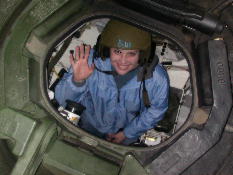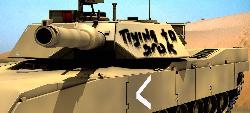March 27, 2006
Once planners choose a base, the astronauts will immediately need to bring a host of technologies to bear, none of which currently exist. "Power is a big challenge," Toups said. Solar arrays are an obvious answer, but away from the poles 14 days of lunar sunlight are followed by 14 days of darkness, so "how do you handle the dormancy periods?"
Next is the spacesuit. Apollo suits weighed 270 pounds on Earth, a relatively comfortable "felt weight" of 40 to 50 pounds on the moon, but an unacceptable 102 pounds on Mars. "You can't haul that around, bend down or climb hills," Lee said. "Somehow we have to cut the mass of the current spacesuit in half."
And the new suit, unlike the Apollo suits or the current 300-pound shuttle suit, is going to have to be relatively easy to put on and take off, and to be able withstand the dreaded moon dust.
After three days, Apollo astronauts reported that the dust was causing the joints in their suits to jam, "and we're not talking about three outings," Lee said of the next moon missions. "We're talking about once a week for 500 days -- between 70 and 100 spacewalks."
Dealing with dust is also a major concern in building shelters on the lunar surface. Toups said it might be possible to harden the ground by microwaving it, creating a crust "like a tarp when you're camping." Otherwise, the dust pervades everything, and prolonged exposure could even lead to silicosis.
Dust also makes it virtually impossible to use any kind of machinery with ball bearings. Civil engineer Darryl J. Calkins, of the Army Corps of Engineers Cold Regions Research and Engineering Laboratory, warned that the combination of dust, low gravity, temperature swings and the high cost of flying things to the moon is going to define the lunar tool kit in unforeseen ways.
"You can't put a diesel up there; you can't put a 20,000-pound bulldozer up there; and none of our oils or hydraulic fluids are going to survive," Calkins said in a telephone interview. "We may have to go back to the 19th century to find appropriate tools -- use cables, pulleys, levers."
And even then, it will be difficult to level a base site and haul away the fill because there's not enough gravity to give a tractor adequate purchase. Instead, Calkins envisions a device that can "scrape and shave" small amounts of soil and take it away bit by bit.
But in the end, "you have to learn how to do it, with real people," McKay said. "This is hard, but we can learn it. And if we do it right on the moon, we will be able to answer my ultimate question: Can Mars be habitable? I think the answer is 'yes.' "
I love that first sentence: "bring a host of technologies to bear, none of which currently exist." It reminds me of Michael Crichton's insight on the horse:
Let's think back to people in 1900 in, say, New York. If they worried about people in 2000, what would they worry about? Probably: Where would people get enough horses? And what would they do about all the horseshit? Horse pollution was bad in 1900, think how much worse it would be a century later, with so many more people riding horses?
But of course, within a few years, nobody rode horses except for sport. And in 2000, France was getting 80% its power from an energy source that was unknown in 1900. Germany, Switzerland, Belgium and Japan were getting more than 30% from this source, unknown in 1900. Remember, people in 1900 didn't know what an atom was.
I can't wait to see what these scientists come up with.
Posted by: Sarah at
04:41 AM
| Comments (3)
| Add Comment
Post contains 706 words, total size 4 kb.
Posted by: Will Somerset at March 27, 2006 04:26 PM (eIQfa)
Posted by: tom Bux at March 27, 2006 06:27 PM (mgjgv)
Posted by: GK at March 27, 2006 10:17 PM (IJedl)
49 queries taking 0.0666 seconds, 200 records returned.
Powered by Minx 1.1.6c-pink.














